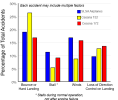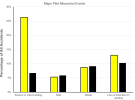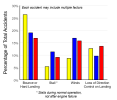You are using an out of date browser. It may not display this or other websites correctly.
You should upgrade or use an alternative browser.
You should upgrade or use an alternative browser.
Ron Wanttaja
- Thread starter Shepherd
- Start date
wanttaja
En-Route
dmspilot
Final Approach
- Joined
- Oct 20, 2006
- Messages
- 5,860
- Display Name
Display name:
DISPLAY NAME
I will guess SLSA is yellow. Although more vulnerable to winds, I think the pilots flying them would have more conservative personal minimums. Additionally, the LSAs I've flown had docile stall characteristics.
Chrisgoesflying
Cleared for Takeoff
Blue
Bill
Touchdown! Greaser!
- Joined
- Mar 2, 2005
- Messages
- 15,105
- Location
- Southeast Tennessee
- Display Name
Display name:
This page intentionally left blank
Yellow - 172 confidence 80%
More 172s out there flown by pilots of various skill and currency levels equals more bounce landing accidents. Also, 172 stalls like a pussycat.
Blue - LSA confidence 50%
Red - 152 confidence 50%
These two are close and could flip flop. Both light and more susceptible to winds causing an accident.
I also could just be talking out of my anal orifice.
More 172s out there flown by pilots of various skill and currency levels equals more bounce landing accidents. Also, 172 stalls like a pussycat.
Blue - LSA confidence 50%
Red - 152 confidence 50%
These two are close and could flip flop. Both light and more susceptible to winds causing an accident.
I also could just be talking out of my anal orifice.
kyleb
Final Approach
- Joined
- Jun 13, 2008
- Messages
- 7,555
- Location
- Marietta, GA
- Display Name
Display name:
Drake the Outlaw
Yellow is LSA. Lots of gear collapses in that segment. (I think.)
wanttaja
En-Route
The main message for the Light Sport-vs-172s-152 plot is that nothing stands out. There's enough froorah about how Light Sports have higher accident rates due to this-or-the-other, yet it doesn't really stand out when you look at the statistics without labels. Like Bill said, some of these are close enough where one could flip-flop.
Here's the art with the aircraft labeled. Note that this has the bars in a different order than the one I posted earlier in order not to put Light Sports as the first column, but the color code is the same. Blue - SLSA, Yellow - Cessna 152, Red - Cessna 172.

This analysis was enjoyable in that it was entirely new ground for me. When I update my homebuilt statistics, I've got twenty years of past experience so nothing's really a surprise. In this case, I got to work from scratch.
Ron Wanttaja
Here's the art with the aircraft labeled. Note that this has the bars in a different order than the one I posted earlier in order not to put Light Sports as the first column, but the color code is the same. Blue - SLSA, Yellow - Cessna 152, Red - Cessna 172.

This analysis was enjoyable in that it was entirely new ground for me. When I update my homebuilt statistics, I've got twenty years of past experience so nothing's really a surprise. In this case, I got to work from scratch.
Ron Wanttaja
Shepherd
Final Approach
Looking forward to part 2.
dmspilot
Final Approach
- Joined
- Oct 20, 2006
- Messages
- 5,860
- Display Name
Display name:
DISPLAY NAME
Are the differences in the percentages statistically significant?The main message for the Light Sport-vs-172s-152 plot is that nothing stands out. There's enough froorah about how Light Sports have higher accident rates due to this-or-the-other, yet it doesn't really stand out when you look at the statistics without labels. Like Bill said, some of these are close enough where one could flip-flop.
Here's the art with the aircraft labeled. Note that this has the bars in a different order than the one I posted earlier in order not to put Light Sports as the first column, but the color code is the same. Blue - SLSA, Yellow - Cessna 152, Red - Cessna 172.
wanttaja
En-Route
I'm inclined to thing they aren't; the basic story is that SLSA airplanes suffer Pilot Miscontrol accidents at about the same rate as traditional trainers.Are the differences in the percentages statistically significant?
I'd love a larger sample size; I've got about 417 SLSA airplane accidents compared to 300 C152 accidents. For the "Bounce or Hard Landing" category, the both had about 80 instances, but with more accidents involving SLSAs, the percentage is lower. According to the FAA Annual Survey, SLSAs fly about 33% more than the overall rate for two-seat airplanes.
What gets fun is comparing the Cessna 152 with another famous training aircraft. This aircraft suffered over 500 accidents over the same time period. Yellow shows the Cessna 152, black shows the mystery trainer.

Could make this another guess-the-airplane game, but I'll ruin it early: The black bar is Cessna 150s...aircraft almost identical to the 152, with the main difference being the engine.
So what happened? I'm guessing the 150s are largely being flown as personal aircraft, while the 152s are in heavier use as trainers. Nineteen percent of the 152 accidents had the PIC as a Student, vs. 11% of the C150s. Light Sport Airplanes had about the same percentage as the C152, which was the main driver for picking it for comparison. C172s were 14%.
This was borne out to some extent by the median total time of the pilots involved. Pilots in the 152 accident had a median of about 105 hours total time, way less than the 395 hours of the 150 pilots.
One of the odd things when comparing the C152 to the C150 was the percentage of time accidents involved a loss of engine power (whether it was the engine's fault or not). Twenty-seven percent of Cessna 152 accidents involved loss of power, vs. 39% of 150 accidents. 15% for C172s, 19% for SLSA airplanes.
The 152 actually had a higher rate of engine mechanical issues, roughly twice that of the 150. The 150, on the other hand, has twice the rate of engine failures due to fuel exhaustion. I think this again reflects the fact that the 150 fleet is being flown as personal aircraft, and less as trainers.
Ron Wanttaja
Ghery
Touchdown! Greaser!
- Joined
- Feb 25, 2005
- Messages
- 10,903
- Location
- Olympia, Washington
- Display Name
Display name:
Ghery Pettit
Interesting. I have 4.1 hours in a 150. I will never voluntarily increase that number. Why? When I run the seat all the way back in a 150 my knees still hit the bottom of the panel when I go for the brakes. I flew a 150 a whole 3 times when I was a student pilot over 20 years ago.
Shepherd
Final Approach
You were right.
The second part wrapped things up nicely.
The second part wrapped things up nicely.

